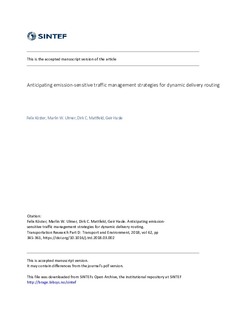| dc.contributor.author | Köster, Felix | |
| dc.contributor.author | Ulmer, Marlin | |
| dc.contributor.author | Mattfeld, Dirk | |
| dc.contributor.author | Hasle, Geir | |
| dc.date.accessioned | 2018-06-05T08:54:13Z | |
| dc.date.available | 2018-06-05T08:54:13Z | |
| dc.date.created | 2018-04-03T10:15:10Z | |
| dc.date.issued | 2018 | |
| dc.identifier.citation | Transportation Research Part D: Transport and Environment. 2018, 62 345-361. | nb_NO |
| dc.identifier.issn | 1361-9209 | |
| dc.identifier.uri | http://hdl.handle.net/11250/2500278 | |
| dc.description.abstract | Traffic pollution is an increasing challenge for cities. Emissions such as nitrogen dioxides pose a major health threat to the city’s inhabitants. These emissions often accumulate to critical levels in local areas of the city. To react to these critical emission levels, cities start implementing dynamic traffic management systems (TMS). These systems dynamically redirect traffic flows away from critical areas. These measures impact the travel speeds within the city. This is of particular importance for parcel delivery companies. These companies deliver goods to customers in the city. To avoid long delivery times and higher costs, companies already adapt their routing with respect to changing traffic conditions. Still, a communication with the TMS may allow anticipatory planning to avoid potentially critical areas in the city. In this paper, we show how communication between TMS and delivery companies results in benefits for both parties. To exploit the provided information, we develop a dynamic routing policy anticipating potential future measures of the TMS. We analyze our algorithm in a comprehensive case study for the TMS of the city of Braunschweig, Germany, a city often used as reference for a typical European city layout. We show that for the delivery company, integrating the TMS’ information in their routing algorithms reduces the driving times significantly. For the TMS, providing the information results in less traffic in the polluted areas. | nb_NO |
| dc.language.iso | eng | nb_NO |
| dc.title | Anticipating emission-sensitive traffic management strategies for dynamic delivery routing | nb_NO |
| dc.type | Journal article | nb_NO |
| dc.type | Peer reviewed | nb_NO |
| dc.description.version | acceptedVersion | nb_NO |
| dc.description.version | publishedVersion | nb_NO |
| dc.source.pagenumber | 345-361 | nb_NO |
| dc.source.volume | 62 | nb_NO |
| dc.source.journal | Transportation Research Part D: Transport and Environment | nb_NO |
| dc.identifier.doi | 10.1016/j.trd.2018.03.002 | |
| dc.identifier.cristin | 1576679 | |
| dc.relation.project | Norges forskningsråd: 263031 | nb_NO |
| dc.relation.project | Norges forskningsråd: 246825 | nb_NO |
| cristin.unitcode | 7401,90,11,0 | |
| cristin.unitname | Anvendt matematikk | |
| cristin.ispublished | true | |
| cristin.fulltext | original | |
| cristin.fulltext | postprint | |
| cristin.qualitycode | 2 | |
